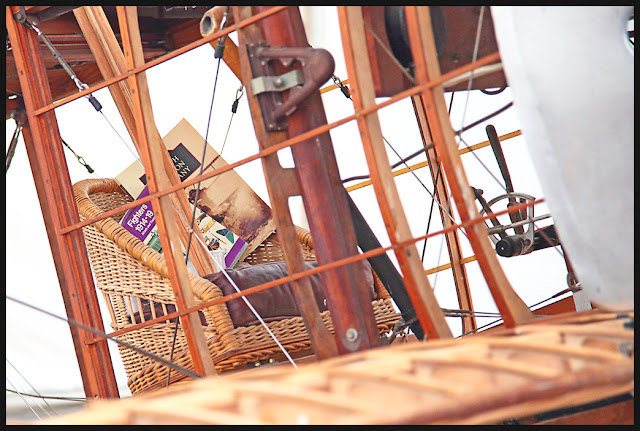I have gleaned the following from an old BBC report.
This Sopwith Pup is being lovingly restored by its owner, Kelvyn Baker, who’s
spent more than three decades on the project.
Sopwith Pups were in service during the early days of naval aviation and I understand were the first type of aircraft to land on a ship at sea.
It was fast and easy to manoeuvre and saw great success in the war.
The engine is a French «Le Rhône» rotary that has
nine cylinders and goes round with the propeller. The actual crank is bolted to
the air-frame and it is quite a good efficient engine for what it is. The model was built as a night fighter, which at the time was
very unusual.
As you can imagine, in 1917 it was pretty rudimentary. In the
cockpit, the instrument-panel lighting consists of little pea-bulbs which are
shaded and the shades have different sized holes in the cover. You turn the shades around to control the
light and it shines onto the instruments as you choose.
So far the project has run into the thousands. Replica metal parts are specially made in
aluminium and cost around £1,000 each to make. There is also the question of the colours to be used for the plane once the frame has been covered. It is known what the specification was when
it came out of the Standard Motor Company, but the aircraft was picked up after
the war and put into civilian garb. It
was assumed from black and white photographs that it was silver, which was a
common colour in those days. However there is a school of thought that it could
have been a shade of blue – a very light sky blue.
These questions have resulted in a lot of detective
work – some still haven’t been answered, like the whereabouts of the plane
after its final flight up until its discovery in the 1970s.
What is known is that after it was decommissioned it was
registered G-EAVX by the Aircraft Disposal Company in Croydon in 1919 and
possibly bought by Aubrey Robert Maxwell Rickards, a WW1 Flying Officer. It crashed during the Aerial Derby, Hendon in 1921 and this was
broadcast on Pathé News at the time. The
pilot, on that flight was Dring Lester Forestier-Walker, was said to have been
drunk. He’d crash-landed it, buckled the
under-carriage and damaged the prop somewhat, but the Sopwith Pup’s life wasn't
over yet.
Evidence was discovered that it wasn’t completely written-off
after this disaster even though it nose-dived straight into the ground. Flight records revealed it had flown as late
as 1922.
In 2007 the aircraft was transported from the present owner’s home
in Winscombe, North Somerset to RNAS Yeovilton. “It was by kind permission of the base
commander, who had a soft spot for it,” said the owner. He and a group of friends expect to complete
it soon.
The restoration has been more of an assembly job. “We’ve got the wing spars on trestles and the
wing ribs just slid on. We need to fit
them properly and glue and nail them on both sides.” Some other spars had to be machined. Once the plane is fully restored and certified
the hope is that can be housed at the Fleet Air Arm Museum and used for
educational purposes.
It will need a replacement propellor before it can be deemed airworthy.
 |
| Airflow powered fuel-pump |
 |
| Detail of the starboard aileron control system |
 |
| An original Sopwith propellor |
The plane was on temporary display at Tynesfield House, North Somerset (a National Trust property). Unfortunately, I was denied access to look into the cockpit and photograph the instrument panel. I was assured that it was complete still and apparently in working order. I was shown a photograph.






















No comments:
Post a Comment